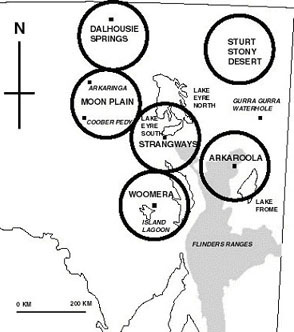Main menu
Analogue Research Site Selection
Jarntimarra-1
Evaluating the Sites
Selecting the Regions
Conclusions
Jarntimarra-1
The Jarntimarra-1 expedition was undertaken to visit, evaluate and rank Australian Mars analogue sites for possible use by the MSA for future field reseach activities such as testing the Marsupial analogue rover and possible future deployment of an Australian analogue research station (MARS-Oz).
Australia is rich in locations geologists have identified as closely analogous Mars to environments observed on the surface of Mars. Initial electronic discussion between MSA members identified many of these, with further research identifying further sites of interest. Sites were nominated on the basis of scientific interest, the range of types of environments in the vicinity suitable for testing equipment, and visual resemblance to Mars. The most attractive sites were in central Australia, and most could be visited in a single 4WD trek.
Evaluating the sites
The Jarntimarra-1 expedition spent two weeks in the field and visited a wide range of sites. These are listed in Table 1. The expedition route is shown in Figure 1. In undertaking this expedition, every effort was made to obtain permission from the stakeholders, owners or custodians of the selected land before the visit took place, though in all cases the visits were non-intrusive. A paper detailing the expedition and site selection process is in press.
| Island Lagoon, Woomera, SA | Mt. Gason Bore, SA |
| The Breakways, Coober Pedy, SA | Mungeranie Bore, SA |
| Moon Plain, Coober Pedy, SA | Lake Eyre South, SA |
| The Painted Desert. SA | Milners Rock Pile, Birdsville Track, SA |
| Henbury Craters, NT | Coopers Creek, SA |
| Finke River Crossing, New Crown, NT | Mt. Gason Bore, SA |
| Mt. Hammesley Plain, SA | Mungeranie Bore, SA |
| Dalhousie Springs, SA | Sturts Stony Desert, SA |
| Lake Eyre South, SA | Clifton Hills dunes, SA |
| Milners Rock Pile, Birdsville Track, SA | Mt Gee, Arkaroola, SA |
| Coopers Creek, SA | Paralana Hot Spring, Arkaroola, SA |
| Mirra Mitta Bore. SA | Lake Frome Plain outwash fans, SA |

Figure 1 - Route of the Jarntimarra-1 expedition
At each site the survey crew filled in a database information sheet. This was a set of 13 prompts for each field in the database: name, date, latitude/longitude, ownership, access, risks, maps, geology, climate, flora/fauna, history, analogue value and references. These provided for factual entries in the Jarntimarra database. To record comparative judgements with respect to the MSA's specific needs there was a separate assessment sheet with a list of 9 scientific and 8 engineering criteria, favouring sites that have intrinsic scientific value and offering a range of conditions in which to test analogue vehicles, spacesuits and other equipment. There was also a set of 7 logistical criteria relating to the distance from facilities and practical difficulty of operations and 8 visual criteria, reflecting the public relations requirement for the site to photograph as if it were the Martian surface (Table 2).
| Scientific Criteria | Engineering Criteria | Logistic Criteria | Visual Criteria |
|---|---|---|---|
| Bedrock geology | Rocky | Security | Climate |
| Geomorphology | Boulders | Accessibility | Surface water |
| Surficial deposits | Sandy | Infrastructure | Colour |
| Groundwater | Dusty | Land tenure | Vegetation |
| Weathering | Firm | Liabilities | Physiography |
| Palaeontology | Chemical Activity | Safety | Landscape process |
| Microbiology | Wind | Outreach potential | Cultural association |
| Extremophiles | Temperature variation | - | Cultural disturbance |
Selecting the regions
A number of key issues for MSA were resolved during a three-day conference at Arkaroola village at the end of Jarntimarra-1. The expedition found that most of the assessed sites fell within the boundaries of only six 200-km diameter circles (Figure 2). The significance of these exploration zones is that each specifies a set of features within easy reach of one simulated Mars mission, given a vehicle capable of extended traverses. If the centre of a circle represents a habitat landing site, all the features within that zone would be accessible by sorties of no more than 100km. Each of these six centres represents a possible "landing site" for MARS-Oz.

Figure 2 - The six prime regions selected during Jarntimarra-1
Based on the collective experience gained while filling in the site assessment sheets, each zone was rated on 5-point scale according to the above specific characteristics. Engineering and science scores then were doubled to reflect their importance relative to the other criteria in the total score. On this basis, the Moon Plain, Woomera and Arkaroola zones achieved equal ranking.
To support the goal of recommending a premier site for the 2002-2003 season, the tie was broken by considering the arguments of individual expedition members advocating each zone. Eventually the case for the Arkaroola region prevailed by virtue of its unique combination of logistical convenience (hospitable base at nearby Arkaroola village; 8 hours road travel from Adelaide; 1200m all-weather airstrip at Balcanoona), international scientific reputation and Mars-like geology.
Specific Mars analogue research in the region has been three-fold, focusing on aeolian landforms, extremophiles, and remote sensing. Studies of aeolian landforms compared Martian dunes at Nili Petra with terrestrial dunes at Gurra Gurra Waterhole in the Strzelecki Desert. The extremophile work found radiation-resistant thermophiles in the Paralana hot spring which is characterised by high levels of radon gas. The area has been used in remote sensing experiments comparing hyperspectral imagery from the alteration halo surrounding the Mount Painter fossil hydrothermal system with ground truth from a hand-held spectrometer. This last study is particularly relevant to detecting the presence of such systems on Mars, which are believed to be good localities to search for microfossils. Potential Mars analogue geoscience research in the area may include palaeontology, geomorphology and regolith studies. The Proterozoic sediments of the area are known to host silicified microfossils and the sinters of the Mt. Gee fossil hydrothermal system show potential for microfossil preservation. Geomorphological and regolith studies include evolution of the alluvial fans on the eastern flank of the Flinders Ranges, nature of mound springs of Lake Frome, and landscape evolution of the northern Flinders Ranges, where uplift has led to partial exhumation and dissection of ancient land surfaces buried beneath Cretaceous cover.
Conclusions
The Jarntimarra-1 expedition examined a wide range of sites across South Australia and the Northern Territory. Many sites were identified which had value as useful Mars analogues.
The preferred site for the proposed Australian analogue research station was on the gravel plains to the east of the Arkaroola zone's central point, between the eastern side of the northern Flinders Ranges and Lake Frome. This was chosen for a number of reasons. It will allow easy access to sites in the Flinders Ranges proper and on the plains that surround Lake Frome. There are many different terrains and areas of extremely high scientific interest in the vicinity. It will also simplify logistics, as a well-maintained, unsealed road runs up the eastern margin of the ranges, joining the Strzelecki Track to the north and the Barrier Highway to the south. The exact co-ordinates of the Hab site will be decided upon during a further expedition after discussion with relevant land holders.

